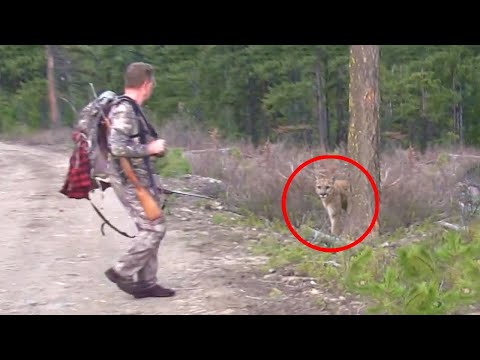Every once in a while, you’ll hear someone talking about how they caught a glimpse of one of the United States’ most elusive inhabitants.

Preternaturally quiet, stealthy and extraordinary hunters, the mountain lion is the largest wild feline on the continent, and rarely encountered even in its natural range.
They are magnificent animals, no doubt about it, but are mountain lions dangerous?
Yes, mountain lions can be very dangerous. Mountain lions rarely approach humans and attack even more rarely, but these big cats are well-equipped with long fangs, sharp claws, and excellent ambush instincts.
Probably the spookiest thing about the mountain lion is that you wouldn’t necessarily even know it was around prior to an attack.
These big cats have an absolutely blood-chilling growl, but they are such stealthy and elusive predators that you might not know you are in trouble until it’s on top and clawing your guts out.
There’s a lot more you can and should know about mountain lions if you’re going to be anywhere in their territory, and I’ll tell you all about it below.
Mountain lions are the largest wild felines in North America, and can be found here and there in pockets across the country, though they’re invariably found in wooded areas.
Mountain lions are true big cats in the tradition of the panther, and can weigh more than 210 pounds (95 kilos).
Even so, they’re highly stealthy and very reclusive, rarely preferring to attack or confront directly.
Typically, these felines live alone inside a vast territory that they claim as their own, and there are most often active when they have a major sensory advantage, typically during the night after dusk and all the way through dawn.
Every now and then you might spot a mountain lion on the hunt or traveling during the day. These big cats, like all cats, are apex predators armed for the task.
They have extraordinary senses of vision, hearing and smell, hooked claws that can open up flesh like a scalpel, and long, penetrating fangs inside powerful jaws that can exert tremendous pressure.
But these cats don’t prey on mice and little birds: Mountain lions are huge predators, and usually bring down deer and other similarly large mammals for food!
And when they do, you better watch out, because mountain lions are notoriously protective of their kills and their territory.
They might try to scare you away, or they might not. Be sure to keep an eye out for the markings they leave behind, typically shredded trees, and other vegetation along with pungent, nasty mounds of feces and urine markings.
Yes, and aggressively. But, these cats can be mercurial they might be just as likely to observe you from a distance if you are passing through their territory as they are to confront you.
If you’re in an area where mountain lions are known to be relatively common, or have been known to frequent in the past, you must be on guard.
Yes. Mountain lions are largely solitary animals, and also highly territorial towards one another. The only time you’re likely to see a couple of mountain lions together is if it is a mother with her kittens.
Males in particular have very short tempers for one another, and fights between males and females, even during mating season are common.
Usually no, but aggression has been displayed in the past and there are many verified stories of mountain lions stalking people for miles.
That is what makes them so particularly dangerous: a mountain lion is just as likely to follow you silently or set up an ambush along your path as it is to confront you and try to give you a scare.
Also, the age of the mountain lion makes a big difference. Much younger mountain lions, and juveniles in particular, are known to be bolder and more aggressive, attacking people and other animals more often and with greater abandon.
On a similar note, mountain lions that are too old, sick or injured to tackle their usual prey might go after people seeing them as something of an easier meal compared to a giant, antlered deer.
Yes, and for a very long time. Mountain lion attacks have been recorded as far back as when the settlers first came to America from Europe, and they have continued ever since.
Since attack incidents started being verified at the turn of the 20th century, there have been more than 125 mountain lion attacks on people in the US, with 27 fatalities attributed to that period of time.
Historical attack numbers are likely to be quite higher, though there is significant uncertainty regarding some historically mentioned attacks.
These attacks are quite rare in the grand scheme of things, especially when compared to other land-bound predators like bears, but they do happen.
Thankfully, deaths are even rarer, but it is unsettling to know that mountain lion attacks have also been increasing sharply since the early 1990s. Always be on your guard in mountain lion country!
Coming into a male mountain lion’s territory is one way to trigger an attack, as is coming anywhere near a mother that has kittens, or coming into the territory of said mother.
Similarly, coming too close to any mountain lion, anywhere, for any reason usually results in a bad outcome if the cat does not retreat.
Mountain lions can also prove to be quite protective of their kills, so if you happen upon a carcass of any larger animal, double your caution.
Also, it must be said that mountain lions will, from time to time, pursue people deliberately as prey.
Many folks who have had close encounters with mountain lines reported a feeling of dread or being watched, in the daytime or in the dark prior to actually spotting the mountain lion or being attacked.
Quite strong. Like all cats, mountain lions are highly athletic, and capable of some genuinely amazing feats of athleticism.
They can scale vertical surfaces faster than you can run, leap anywhere from 40 to 50 feet (12 to 15 meters) while on the ground, and can jump straight up 20 feet (6 meters) or higher.
Also, their sheer strength means they can use their claws and teeth to devastating effect when bringing down a target, though they try not to make a messy fight out of things…
Their usual MO is to try and dispatch an animal quickly with one good bite to the back of the neck or the head, which kills or cripples instantly.
Absolutely! Mountain lions have a tremendously powerful bite and long, strong fangs that they use to deliver a killing strike to any animal they can bring down.
As mentioned above several times, mountain lions are supremely skilled ambush predators though full frontal attacks are not unheard of.
Generally, a mountain lion attack begins by leaping at or on top of the prey from a concealed position which might not be anywhere nearby since these cats can jump dozens of feet in a single bound.
Once they have tackled the prey, the cat will scramble for position and attempt to deliver one fatal bite to the back of the neck or the head of the targeted animal, including people, in order to snap the spinal cord and kill or cripple quickly.
They will also use their claws in a head-to-head fight, though these are primarily for hanging on to and manipulating prey in order to deliver the bite.
If you’re lucky enough to spot the mountain line before it attacks, make eye contact with it, don’t crouch down, and keep moving, preferably away from the cat.
Make yourself look as big as possible. Bunch together with other people, and pick up your children if you have any with you, although you shouldn’t kneel down as previously mentioned.
Staying big, keeping eye contact, and staying on the move are likely to discourage a mountain lion from attacking. Remember, they do not want a head-to-head fight if they can avoid it…
If the attack cannot be discouraged or if you’re blindsided by an ambush, then fight back with absolutely everything that you have.
Most mountain lions will disengage when the targeted creature puts up a stiff fight. Use weapons if you can bring them to bear, but lacking that, grab a rock or even use your fists and attack the cat back.
Also, do everything you can to protect your head and neck because the mountain lion will be targeting them.
Yes. Any mountain lion that kills a human being for any reason is highly likely to eat the body.
Mountain lions are also notorious for dragging away a kill over a long distance to stash it and eat it at leisure over the course of several days or weeks.
Yes, though these are obviously not your biggest concern if you are being attacked by one! The most worrying disease that mountain lions are known to carry is trichinosis, but they’re also hosts to a variety of internal and external parasites.
 Like what you read?
Like what you read?
Then you’re gonna love my free PDF, 20 common survival items, 20 uncommon survival uses for each. That’s 400 total uses for these dirt-cheap little items!
Just enter your primary e-mail below to get your link:
We will not spam you.


 Watch this video on YouTube
Watch this video on YouTube